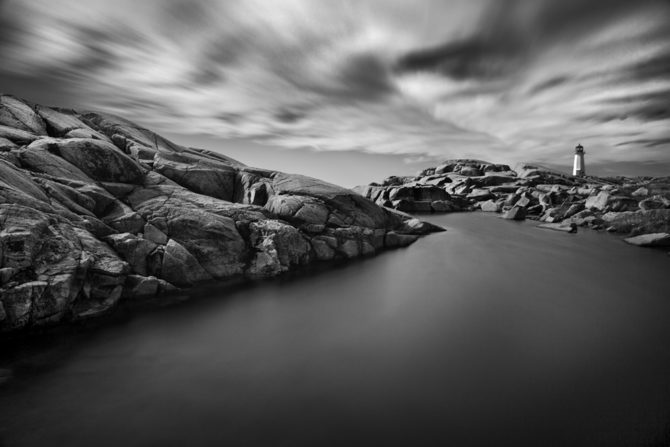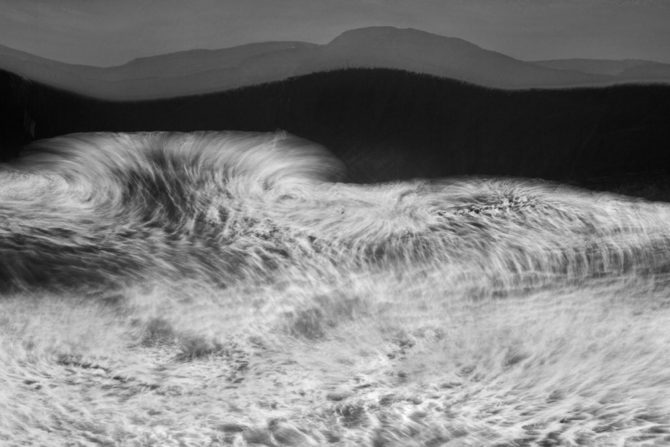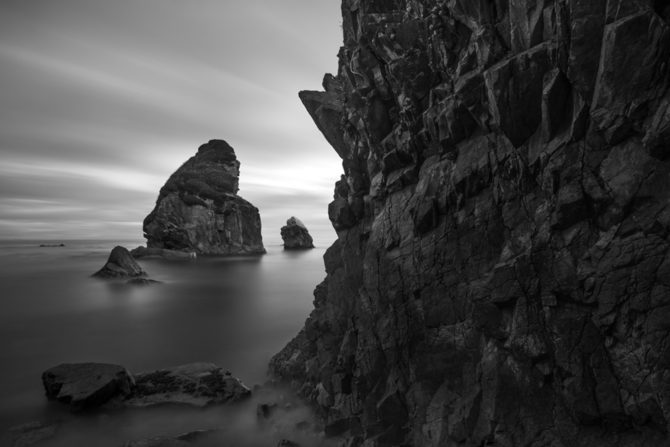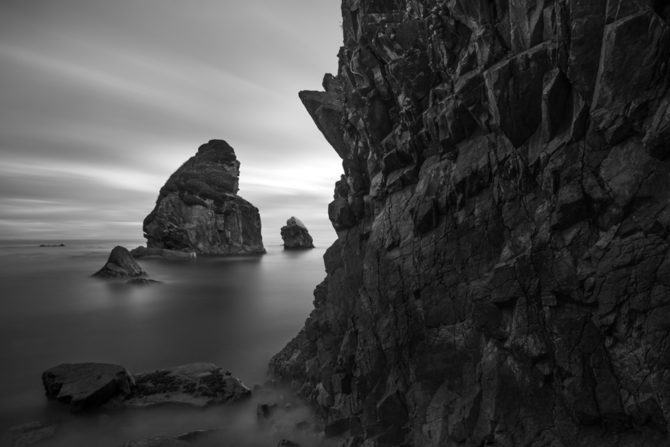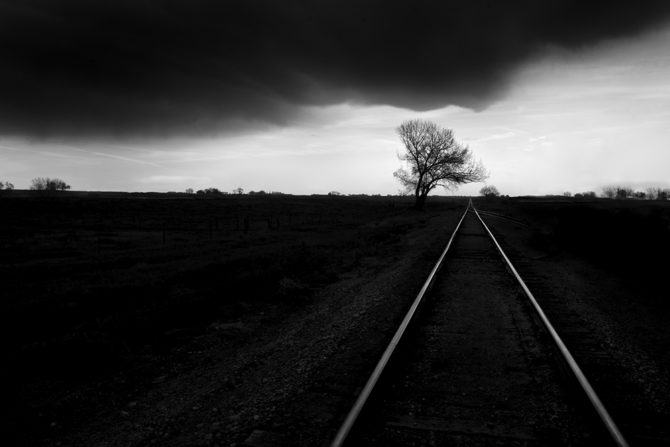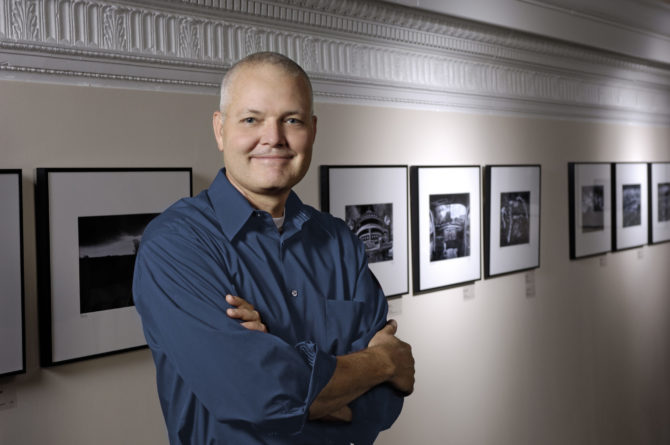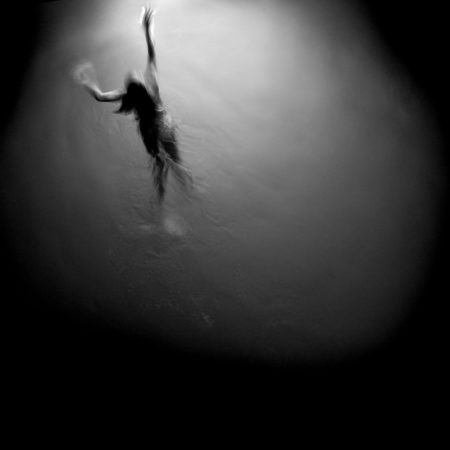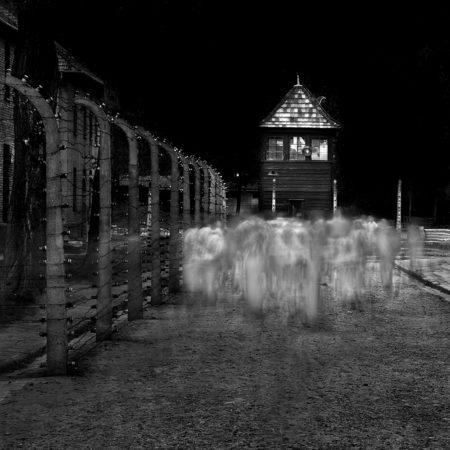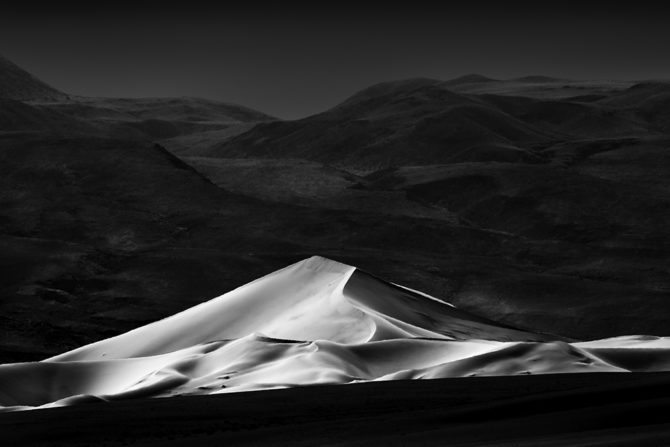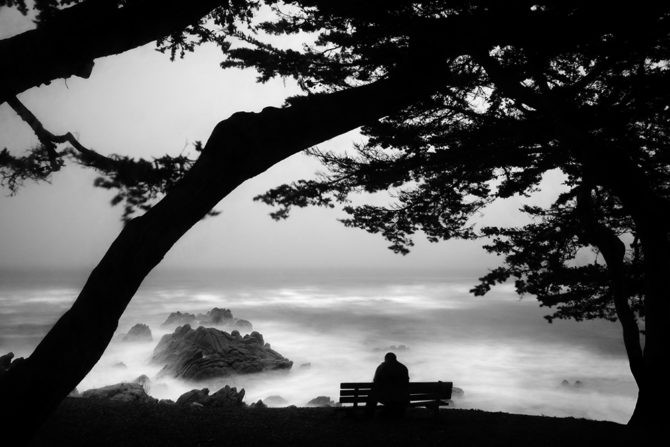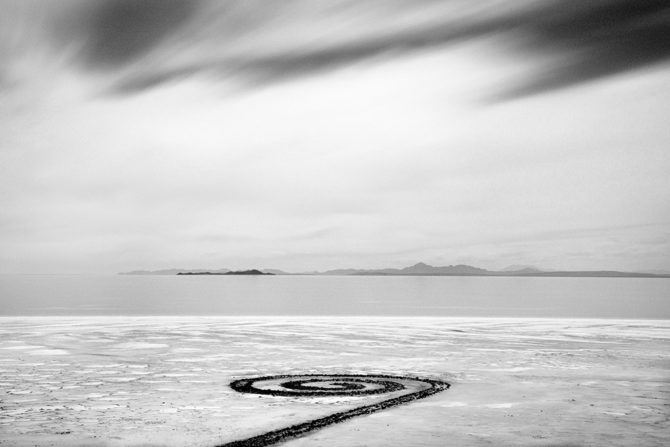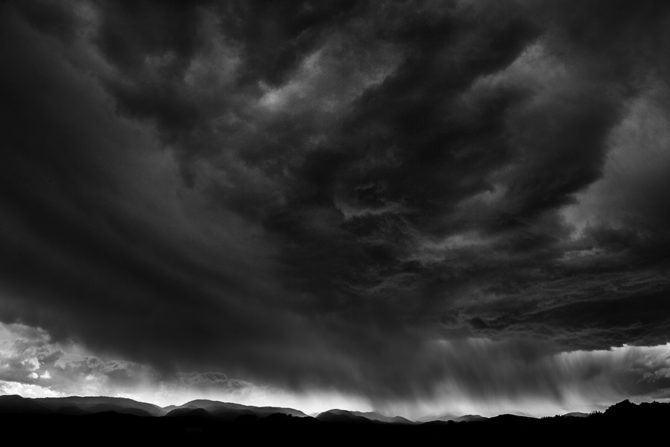Category: Philosophy
November 6, 2015
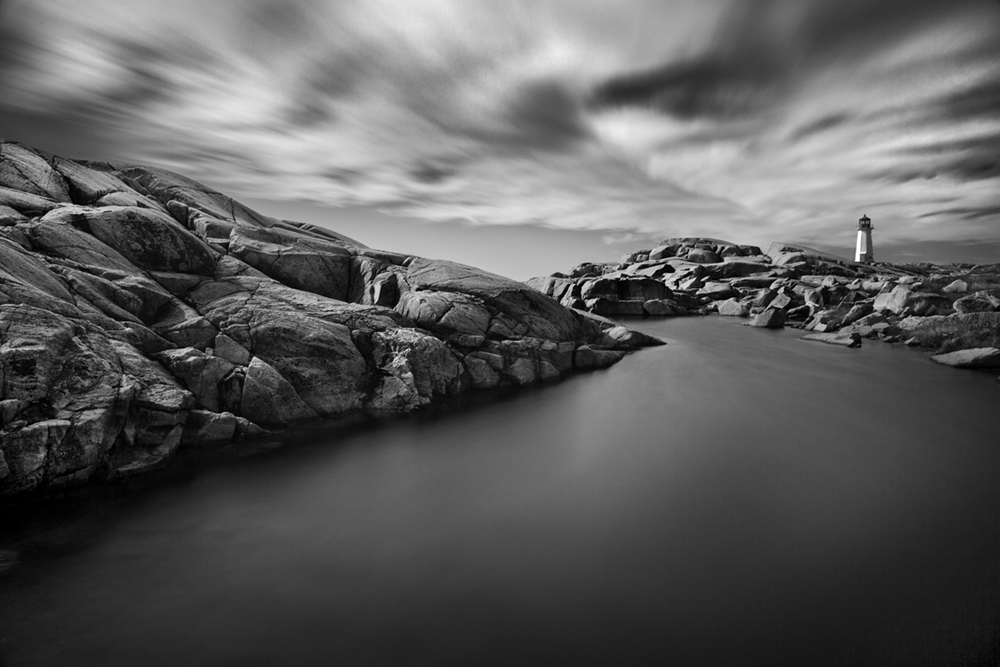
Peggy’s Cove, Nova Scotia
I’ve just driven 7000 miles in 22 days and during that time traveled through 22 states and 2 Canadian Provinces. That’s a lot of time in the car and it afforded a lot of thinking.
And what I’ve been thinking about is Passion and how it relates to Vision.
I noticed that as I drove through the incredibly beautiful autumn scenery of New England, I was not inspired to create. But when I came across water of any kind, and particularly along the coast, I found myself excited and creating.
Now one might initially attribute this to me being a black and white photographer in the middle of a color wonderland. But I don’t think that’s what it was. Fall colors can make for some amazing black and white images and I know that there are great images in those hills.
And yet here were thousands of photographers flocking to the area to shoot the beauty of the mountains and trees…and I’m only taking the occasional iPhone snapshot to send back to my family! Why?
My conclusion is that I just don’t feel a Passion for mountains and trees, but I do for water.
But “why” do certain environs inspire me while others do not? I don’t know and the “why” is not very important to me: what’s important is that I recognize the source of my Passion and then do something about it.
In the past I’ve tried to force projects that I didn’t have a Passion for: the projects languished, I had to force myself to work on them and I was not happy with the results. Not one of those projects were ever successful.
Never. Not one. Ever.
And so I’ve decided that with my limited time I will only focus on the places and things that excite me most, and for now that’s water and the coast.
I’ve long understood the role of Vision in creating work that I love, but now I’m beginning to appreciate the role of Passion as being nearly as important.
With Vision I can create unique images. With Passion comes an excitement that drives me.
And while I might use each one individually to some success, I now realize that my best work is created at the intersection of Vision and Passion.
Cole
October 23, 2015

Are you a professional or an amateur? And what exactly do those titles imply?
For years I have heard people proudly call themselves a professional or apologetically confess that they were “only an amateur.”
In modern times “professional” has come to imply high quality and of course an “amateur” does amateurish work. No wonder everyone is embarrassed to be an amateur and wants to be a professional.
I’m afraid we’ve lost sight of what the word amateur really means: it originates from the French and Latin and means “lover of.” The word refers to someone who does something because they love to do it, they are not formally trained and they do not earn their living from it.
I have always referred to myself as an amateur because I am self taught, I chose not to earn a living from my art and because most importantly I create because I love to. And also there is a part of me that refuses to play the name game, trying to impress others with a title that does not fit.
This week I tried an experiment: I’ve been shooting in Nova Scotia where I have been asked many times if I were a professional (I really think it’s the tripod). I normally answer “no” to this question but had an idea after reading last weeks comments and thought I’d try something different. So this week I answered instead: “I’m a fine art photographer.”
It’s a technique that I’ve seen employed before: give an answer, but not to the question that’s been asked.
It was interesting how it worked, I could see in people’s faces that they weren’t quite sure if I had answered the question and they were certainly not sure what a fine art photographer was (I don’t blame them!). But it then led to a discussion about what I did.
I liked how this answer worked, only one person saw through my misdirection and asked again: “so are you a professional?”
Does it matter what we’re called? Unfortunately to some people it does.
It’s a shame that we are sometimes are judged by our titles, instead of by our work.
Because ultimately the image is the only thing that matters. We can hide behind a title, but our images cannot!
Cole
October 15, 2015

Recently while photographing on the the Oregon coast, a woman on a bicycle stopped and announced that she loved to talk to photographers. Her first question to me was: Are you a professional?
In a split second my mind calculated the several different responses that I could give her:
- Yes.
- No.
- What is a professional?
- What does it matter what I’m called?
- Wouldn’t you rather know if I’m any good?
Because all the definitions I had seen for “professional” were income based (you must earn at least 50% of your income from your photography) I chose a simple “No” for my response.
The woman then rode away, asking no further questions.
I just smiled.
Cole
October 9, 2015
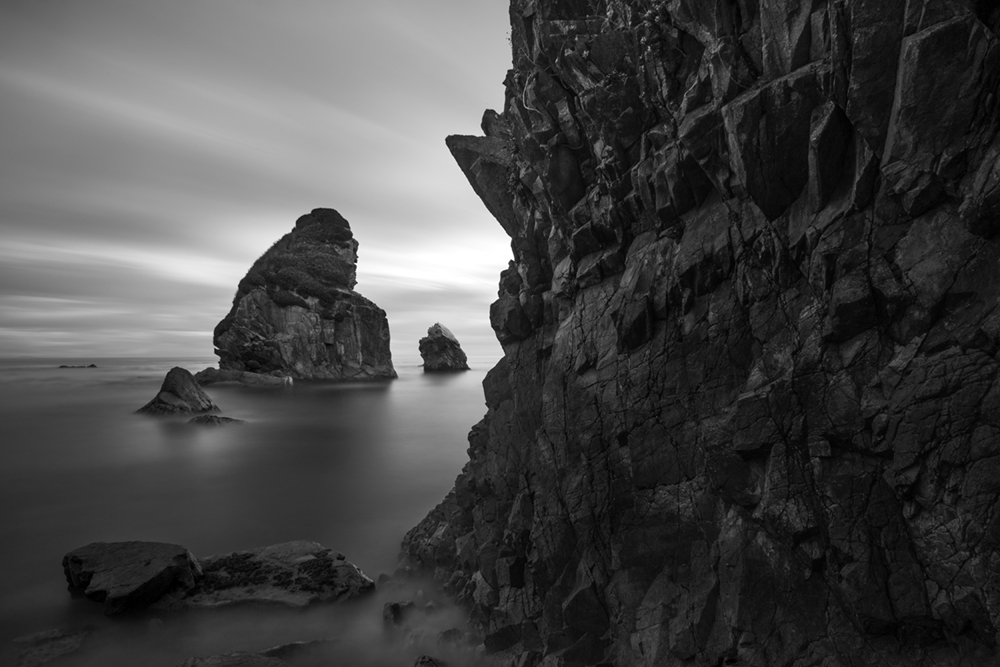
Last week I asked: “What’s Wrong With This Picture?”
Many of you guessed that I was up to something because I never list specifications and I never ask others about my work (it’s a Vision thing).
So what was the real point of the post? It was that the listing of technical specifications detracts from an image. They’re not just superfluous, but they actually detract from the viewing experience.
Listing specifications draws attention away from the only thing that matters (the image) and it furthers the folly that with the right equipment and processes…anyone could create this image.
- If only I had a full-frame camera…
- If only I had those “white” lenses professionals use…
- If only I had a tablet with 2048 levels of sensitivity…
- If only I had an 8-core processor…
- If only…
- If only..
- If only…
I loved what Stephen said in his comment: “An artist doesn’t praise or blame their tools, what only matters is their final work.”
There were other comments that brought up some important points that I’d like to reinforce:
1. Equipment and processes do not an image make. If I had to choose between the best equipment in the world but without my Vision…or a Kodak Brownie with my Vision…I’ll take the Brownie.
2. Never learn the rules of photography. But if you already know them, try to forget them and vow to never consider them when creating an image. Rules are an inadequate substitute for Vision.
3. Create for yourself. When you create an image you should only care what you think of it and not be concerned what others think. The best success is when you create an image that you truly love.
4. There is no right/wrong or good/bad when it comes to art. There is only what you like and don’t like. Please don’t be fooled into thinking that if more people like an image, that it’s a better image. The only thing it means is that more people like the image.
5. Never ask others about your images. Don’t you know what you want? Haven’t you discovered your own Vision? If not, then listening to another’s opinion will not help you find it, but will actually harm the process.
6. Don’t give other people advice about their images, even if they ask. Why not? Because it’s their image and what you think or would do with it is unimportant! (sorry to be so blunt)
When people ask me what I would do with their image, I say: It doesn’t matter what I would do, what is your Vision for it? If I kept telling you what I would do and you kept following my advice, it wouldn’t take long before your images would start to look like mine! (which is not a good thing)
7. The creator gets the final word. When I showed this image to my wife, the first thing she said was: “I like it but you should get rid of some of that rock wall.”
My response was: “No, this is how I see it.”
And unlike most things in marriage, I get the final word when it comes to my images!
While the original point I wanted to make with this blog post was that the listing of specifications is not a good idea, I think the more interesting discussion has been centered around Vision. And as you might have noticed, I am fixated on Vision.
Why? Because finding your Vision changes everything. It gives you the confidence to create what you want without the need for validation or the fear of criticism.
Vision changes the image and it changes the image maker.
Cole
October 1, 2015

I’ve just spent the last ten days creating new images on the Oregon coast. Conditions were wonderful!
This is my latest addition to the “Monolith” series: Monolith No. 85
Specifications:
Canon 5D Mark III, Canon EF 24-105mm f4 “L” lens set at 24mm
ISO 50, f-22, 314.1 seconds using a Singh-Ray Mor-Slo 15 stop fixed ND filter
The tripod is a Manfrotto MT057C3 Carbon Fiber with a Manfrotto Model 486rc2 Ball Head.
This image was shot in RAW and written to a Kingston 266X 64gb CF card and co-written to a PNY 64gb 90mb/s SDXC card.
The RAW image was imported using Photoshop Camera 9.1.1 and the post processing done with Photoshop CC 2015.0.1 Release, build 20150722.r.168 x64.
I processed the image using my Wacom Intuos PTK-840 tablet with 1024 levels of pressure sensitivity.
The image is a 16 bit TIFF with a resolution of 5760 X 3840.
This was processed on my Velocity Micro PC, a Raptor Z95 mATX with 32gb DDR4 2400mhz RAM, a 1000 watt power supply, a Gigabyte X99m mother board with the Intel X99 chipset and the Intel I7-5820K 6-core processor. Video is a 2gb NVidia GeForce GTX960 Video Card GDDR5. It’s cooled using Liquicool’s 8 loop closed loop liquid heatsink.
So, what’s wrong with this picture? Leave your comment and I’ll weigh in next week with my opinion.
Cole
September 17, 2015
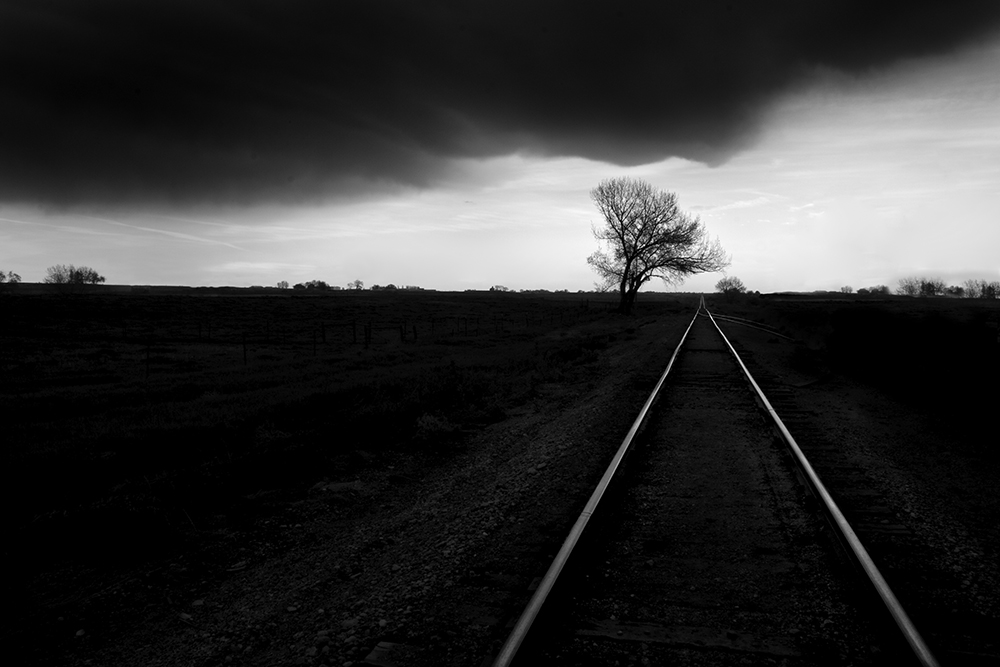
Railroad Tracks
It’s all about the image and nothing else matters.
It doesn’t matter what awards the image has won.
It doesn’t matter what gallery it’s in.
It doesn’t matter how many prints have sold or for how much.
It doesn’t matter if the image appeared on the cover of a magazine.
It doesn’t matter where the image was taken.
It doesn’t matter what equipment was used.
It doesn’t matter if the image was taken with a prime or zoom lens.
it doesn’t matter if it was created with film or digital.
It doesn’t matter what program or plugins were used.
It doesn’t matter what printer, ink sets or paper were used.
It doesn’t matter who the photographer is.
It doesn’t matter if they are famous or not.
It doesn’t matter where they went to school.
It doesn’t matter what famous photographers they studied with.
It doesn’t matter what critics think of the image.
It doesn’t matter what anyone else thinks of the image.
The only thing that matters is the image and how you feel about it.
Nothing else matters.
Do you like it?
Wonderful!
Enjoy it.
Don’t over-analyze it.
Simply enjoy it.
You don’t like it?
Maybe the image failed.
Or maybe…you simply don’t like it.
That’s okay.
We all have different tastes.
August 6, 2015

Cole Thompson was one of the featured speakers at the 2014 PSA Conference. We heard so many good things about his talk that we asked him to write an article for the PSA Journal so those who were unable to attend the conference could read some of what he talked about then. Photos © Cole Thompson
Ten Things I’ve Learned in Fifty Years
by Cole Thompson
I picked up the camera after reading the biography of George Eastman as a 14-year-old boy living in Rochester, NY. Before I finished that book, before I had taken my first picture and before I’d ever seen a print come up in the developer…I was convinced that I was destined to be a photographer. I know that sounds silly, but it’s how I felt then and it’s how I feel to this day.
Many people ask me, “But why black and white? You were born into a color world!”

I reply, “No, I was born into a black and white world!” When I was growing up the world was in black and white.
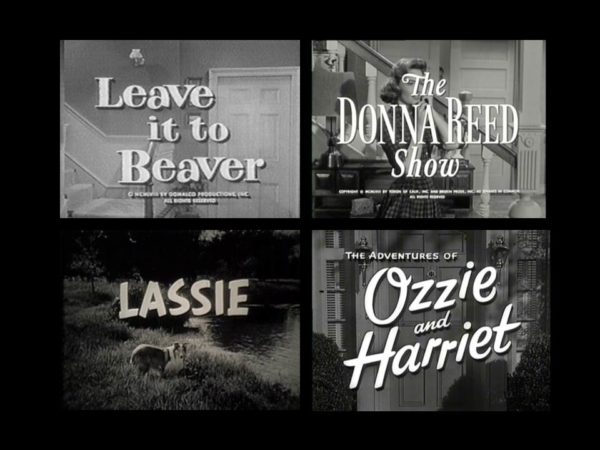
TV was in black and white, movies were in black and white, the news was delivered in black and white, my childhood heroes were in black and white…
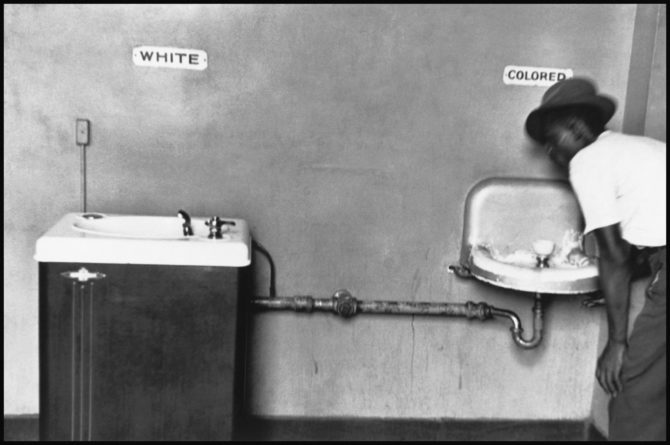
…and even our nation was segregated into black and white.
So I photographed in Black and White and perhaps my images are an extension of the world that I grew up in.
As I think about that innocent young boy I once was, I’m reminded of what motivated me to take pictures those 50 years ago; it was for the pure joy of creating.
But along the way I became a little lost and started creating for the wrong reasons: for fame, fortune, accolades and affirmation until one day I realized that photography was not as fun as it once had been. Today I’ve come full circle and have arrived where I started off; I’ve once again discovered how to create for the pure joy of creating.
Here are some things that I’ve learned that has brought me back to loving photography again and creating the best work of my life.
Here are 10 things that I’ve learned in 50 years:
1. Don’t Aspire to Become the World’s Greatest Imitator.
When I was younger, the ultimate compliment someone could give me would be to say, “Your work reminds me of Ansel Adams’ work.” Because he was my childhood hero, I would dream of creating images just like him. I’d imitate his style and sometimes I’d even go to Yosemite and try to recreate specific images!
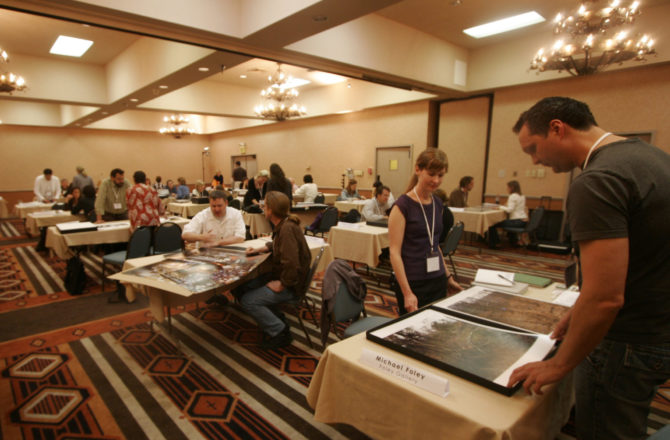
Then several years ago I was attending Review Santa Fe where, over the course of a day, my work was evaluated by a number of gallery owners, curators, publishers and experts in the field.
During the last review of a very long day, the reviewer quickly looked at my work, brusquely pushed it back to me and said, “It looks like you’re trying to copy Ansel Adams.” I replied that I was, because I loved his work!
He then said something that would change my photography and my life: “Ansel’s already done Ansel and you’re not going to do him any better. What can you create that shows your unique vision?”
Those words really stung, but over the next two years the significance of his message sank in. Was it my life’s ambition to be known as the world’s best Ansel Adams imitator? Had I no higher aspirations than that?
I came to realize that I needed to create work that was uniquely mine and not imitative of another. But how was I to do that I wondered? There isn’t a subject that hasn’t been photographed before, so how could I create unique work?
While it’s true that almost everything has been photographed, it has not been photographed through my eyes. We each have a unique Vision and that’s how I can create unique work. The choice was clear: Did I want to imitate or create?
In the end I decided that I’d prefer to create a mediocre original, rather than make a brilliant copy.
2. Vision is Everything
I believe that Vision is what gives your image a soul and it’s what makes your images unique. Great images do not come about because of equipment and processes, but rather from Vision that drives those tools to do wonderful things. What good are great technical skills if you don’t have a Vision worthy of them?
A lot of people have asked me how to go about finding their vision. I’m not sure I can answer that for everyone, but I can tell you how I found mine.
What is Vision?
I desperately wanted to know if I had a Vision, but I had a huge problem. What exactly was Vision and how did I develop it? I researched Vision but I couldn’t relate to the definitions and explanations that I found. Was it a look, a style or a technique? Was it something you were born with or something you developed?
And then there was the nagging doubt: What if I didn’t have a Vision? I feared that it was something you either “had” or you “didn’t have” and perhaps I did not?
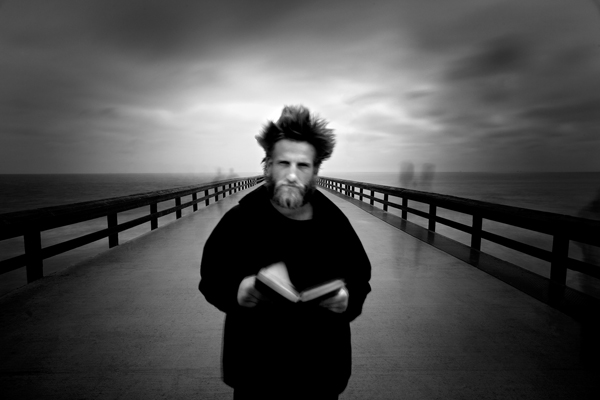
And how was I to go about finding my Vision?
With so many unanswered questions and with no idea on how to proceed, I simply forged ahead and did what made sense to me. Here are the steps that I took:
I Sorted My Images into Two Groups. I took my best images, printed them out and then divided them into two groups: the ones I REALLY loved…and all the rest. I decided that the ones that went in the “loved” pile had to be images that “I” loved, and not just ones that I was attached to because they had received praise, won awards or sold the best. And even if I loved an image that no one else did, I still picked it.
I Made the Commitment. I committed that from that point on, I would only pursue those kinds of images, the ones that I really loved. Too often I had been sidetracked when I chose to pursue images simply because they were popular with others.
I Practiced Photographic Celibacy. I started practicing Photographic Celibacy and stopped looking at other photographer’s work. I reasoned that to find my Vision, I had to stop immersing myself in the Vision and images of others. I used to spend hours and hours looking at other photographer’s work and would find myself copying their style and images. When I looked at a scene I didn’t want to see it through another photographer’s eyes, I wanted to see it through mine!

I Questioned My Motives. One of the hardest things I did was to question my motives and honestly answer some hard questions: Why am I creating?, Who am I trying to please?, What do I want from my photography?, How do I define success? It seemed to me that Vision was something honest and that if I were going to find my Vision, I had to be honest about the reasons I was pursuing it.
I Stopped Caring What Others Thought. I made a conscious decision to stop caring what others thought of my work. I recognized that in trying to please others, I was left feeling insecure and empty. I reasoned that at the end of the day it was just me, my work and what I thought of it. As long as I cared what others thought, I was a slave and could never be free.
What I Discovered. I really was proceeding blindly, but I believed that if I listened to my own desires, pursued what I loved and eliminated all other voices…I would learn something about my Vision. I did this for two years and there were many times that I became completely discouraged and felt like I was failing. I’m not sure what I expected to happen, perhaps I thought I’d have a revelatory experience where my Vision would suddenly appear in a moment of inspiration. But that didn’t happen.
And then one day it simply occurred to me that I understood…I understood what my Vision was. It came in an anti-climactic and quiet moment of understanding, and after all of that worrying and angst…it now seemed so incredibly simple. Vision was not something I needed to acquire or develop, it had been there all along and all I had to do was “discover” it.
Vision was simply the sum total of my life experiences that caused me to see the world in a unique way. When I looked at a scene and saw it a certain way…that was my vision.
I also learned that Vision is not a look or a style. It does not require you to focus on one subject or genre and following your Vision will not make your work look all the same. Vision gives you the freedom to pursue any subject, create in any style and do anything that you want.
3. Don’t Compare Your Work to Others, Art is not a Competition
I noticed that when I compared my work to other photographer’s work, it caused me to have doubts about my abilities and left me deflated. All I could see were their strengths and my weaknesses, which was an unfair comparison.
It’s good for me to periodically remind myself of a few things. If my goal is to produce the best work that I can, then it does not matter what other photographers are doing. As my mother used to say, “Cole, you just worry about Cole.”
Art is not a competition; someone does not have to lose for someone else to win. I am not competing against others…I am trying to be better than myself.
4. Simple is Better than Complicated
I have embarked on a mission to simplify my photography by disposing of everything that is not absolutely necessary to create the image. I have simplified my equipment, my post processing, my matting and framing. I now work with a camera, tripod, three lenses and some filters. I use Photoshop and six of its tools. I use a printer with stock inks.
If a piece of equipment or a process is not necessary, I get rid of it. For too long I was a technophile who almost worshipped my equipment and at times it seemed as though my equipment was more important than the image itself!
I’ve adopted this “simple” approach as a way to focus myself on the things that really do matter: my Vision and composition. Some people feel that they cannot produce a good image with just the simple basics, but I disagree. From my experience the basics can produce incredibly beautiful images that most people would envy.
I’m not saying that there aren’t some gadgets and programs that would improve the quality of your work, but by far the largest improvement any of us can make is to improve ourselves before our equipment. I tell people that if there is a place for some of these extras, it comes after our Vision and composition has been mastered. Simple is always better than complicated.
5. If You’re Not Passionate About Your Project, Choose A New One.
Sometimes people ask me what they should do when they find it hard to get motivated on their project. My answer is, “find another project.” For me, a successful project must have two ingredients: Vision and Passion. If I don’t feel these, I know the project is doomed; it will be a chore to work on and that lack of passion will be felt by the viewer.
Many feel that the key to a successful project is to have a unique subject, an exotic location or an interesting technique. And while those qualities may help, only Vision and Passion can ensure success. When you have a Vision and Passion for your project, that energy and conviction will be felt through your images.
After I created my Ghost series at Auschwitz, many people suggested I apply the ghost theme to other locations. The idea sounded logical: the Auschwitz series had been well received and so why not leverage that popularity by using the same approach at other locations? So I started to work on “The Ghosts of Great Britain” where I created ghosts at English castles. But the project fell flat because the images were not compelling and it felt gimmicky to me.
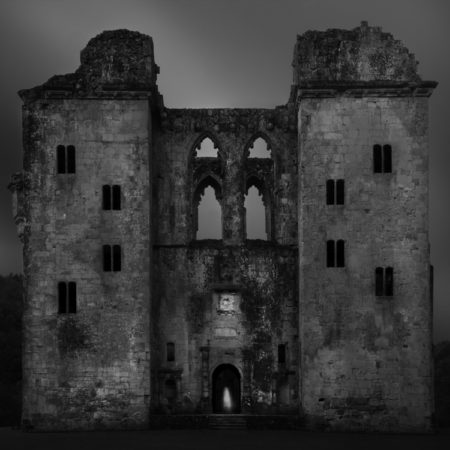
So what went wrong with the project? Simple, it lacked Passion. At Auschwitz I felt inspired to create those images and I had a Vision for the project. I gave no thought as to how the series would be received and in fact I didn’t care!
However “The Ghosts of Great Britain” was completely contrived and calculated to be popular. I did not feel that same Vision or Passion for the project and it failed. I scrapped the series and only kept the one image above. This was a great lesson for me and a mistake that I will never make again.
6. Don’t Follow Any Photographic Rules
What photographic rules should you follow? None, unless you want to create average images that thousands of other people have created before you. Ansel Adams said, “ The so-called rules of photographic composition are, in my opinion, invalid, irrelevant, immaterial.”
I’ll go one step further and say, “In my opinion following the rules of photography is actually harmful because they get in the way of developing independent creativity and Vision.”
Creating compositional rules is an attempt to distill the creative process into a series of guidelines that, if followed, will produce a great image. Do you remember the old “paint by numbers” kits? We were promised that if we’d simply follow the rules by using the proper color, and paint that into each numbered area, and stay within the lines…we would have a masterpiece!
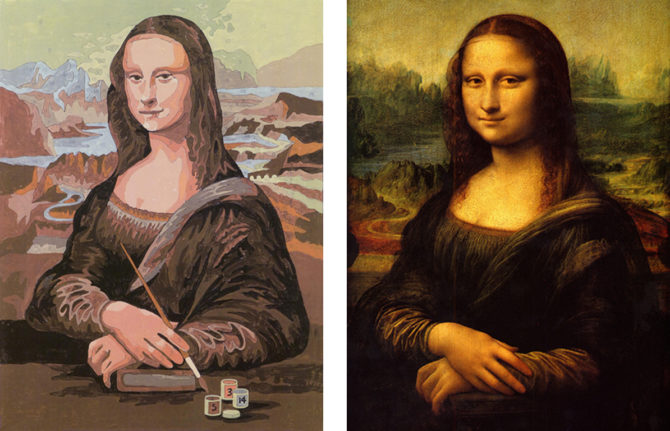
Well, maybe a “competent” painting, but certainly not a masterpiece!
Do you remember IBM’s Deep Blue computer? It was programmed to play chess and it beat the world champion chess player, Garry Kasparov. Do you think that if we were to program the rules of photography into Deep Blue and take it to Yosemite, that it could beat Ansel Adams? Of course not, because composition is about seeing and feeling, not about following rules. And the irony of these rules is that they are supposed to help you learn to be creative, when what they actually do is cause creative dependency.
When I approach a scene, I simply look and see and feel. I compose instinctively until the scene feels right, without a single thought about the “rules.” And if the composition doesn’t feel right, I change it. In the end all I care about is that the image “feels right.”
What a simple and empowering concept; to see and feel for yourself rather than following rules. Creative people already know this secret, that
great art comes from within and is not found in a set of rules.
7. Don’t Listen to Other People’s Advice
Do you know anyone who feels free to offer advice about your images? They often say something like this: “Here’s what I would do…” or “If this were my image I’d…” The problem with other people’s advice is that it doesn’t come from your Vision, but rather theirs.
People will often send me an image and ask what I would do to it and here’s how I respond: If you were to follow my advice, after a while your images would start to look like mine! Is that really what you want? Wouldn’t you rather find your own Vision and create your own masterpieces?
So much of the advice people offered me never felt right and I was torn between respecting the recommendation of experts or following my own intuition. In the end I decided that only by pleasing myself could I create my best work; and that no matter how expert someone was, they were not an expert about my Vision.
Follow my advice and don’t listen to other people’s advice!
8. Use Photoshop However Works Best for You
I use a very simple workflow and for years I would never let anyone see me work because I thought I was doing everything wrong. As I listened to other photographers talk about their sophisticated processes, I was embarrassed to let them see my rudimentary ones. What if they started talking to me about layers or curves…I didn’t use or even understand them!
With time I came to the realization that photography is not about the process, it’s about the image. Nothing else matters. There are many ways to use Photoshop and I doubt that many photographers use more than a small percentage of its many tools. There is no right way or wrong way to use it and not one workflow will be right for everyone.
My procedure works for me and I’d like to share it to illustrate a point: You don’t need to know a lot about Photoshop or have a complicated workflow to produce beautiful images. I use only six tools in the processing of ninety-nine percent of my images.
1. RAW Converter—I use Photoshop’s RAW converter to set my image to a 16 bit, 360 ppi, 10×15 TIFF file.
2. B&W Conversion tool—I like Photoshop’s b&w conversion tool and play with each color channel to see how it affects the different colors of my image.
3. Levels—One of the most basic secrets to a great b&w image is to have a good black and white. I use Levels to set the initial black and white point and I use the histogram to judge this. You cannot trust your eyes and so throughout my processing I keep my eye on that histogram to maintain a true black and white.
4. Dodging and Burning—This is where I do most of my processing and where I have the most fun! I feel most at home with dodging and burning because that’s how I worked in the darkroom. I use a Wacom tablet to dodge and burn, which gives me precise and natural control.
5. Contrast Adjustment—After I have the image looking great on screen, experience has taught me that the print will look flat, and so I add some contrast. A monitor uses transmitted light and a print uses reflective light. That means it will take a lot more work to get your print to look as snappy as it does on the monitor. Contrast helps a great deal.
6. Clone Tool—I use the clone tool to spot my images. Cloning is so much better than the old days when you had to spot every single print and your mouth tasted like Spottone all day!
The point I am trying to make is that a workflow need not be complicated to be effective. I doubt a workflow could be simpler than mine! What’s the best way to use Photoshop? Any way that works for you!
9. Technical Skills and Equipment are not the Key to a Great Image.
Technical skills and equipment are not nearly as important as we think! If I had to choose between the best equipment in the world and no Vision or having a Kodak Brownie and my Vision… I’ll take the Brownie.
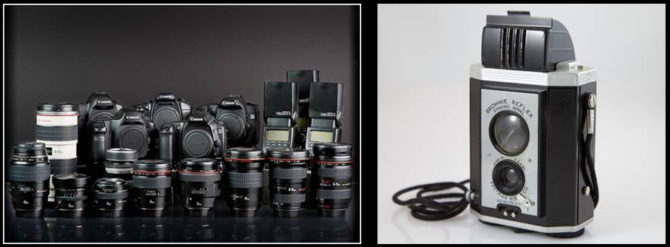
I’m often asked, “What’s the best camera, lens or paper? My answer is always the same: There is no “best.” Most cameras are excellent, almost all lenses are better than their masters and choosing a paper is simply about personal preference.
It’s easy to buy into the notion that the right camera, lens, accessories, plug-ins, printers or paper will transform our ordinary work into extraordinary images. However, from my experience great images are rarely great because they are technically perfect or printed on the right paper.
Put more bluntly: I don’t think it really matters which equipment or paper you choose because they are not the critical component in a great image.
I believe a great image is created mostly from your Vision and that equipment and technical skills play a much smaller supporting role than we generally think.
Vision is what makes an image great and what drives our equipment and processes to do great things.
10. Define Success for Yourself.
I was reading about how the movie “The Beaver” failed miserably at the box office. The article talked about how Jodi Foster, who starred in and directed the film, had faith in the film’s message, and when asked about the financial disaster said, “I’ve learned…that if you gauge your self-worth at the box office you will be a very sorry person.“
How do I, as an artist, gauge my self-worth? Do I base it on how many “likes” I get on some social network? Or do I base it on sales, reviews, the galleries I’m in or the awards I receive? For many years I never stopped to ask myself what success meant to me, I just assumed it meant all of those things.
But as I started to achieve success, I noticed that I wasn’t any happier than when I was “unsuccessful” and in some ways I was less happy. Sure it felt good to have my fifteen minutes of fame, but in the morning it was just me, my art and what “I” thought of it.
So I set about to define success for myself and to identify what I wanted to achieve with my photography. It turns out that my definition was quite a bit different than the one I had been chasing for so long! It turns out that I had been trying to achieve something that I really didn’t want.
This lesson learned was second only to the lesson about Vision: Define success for yourself before you go chasing it.
Conclusion:
Most of what I have learned in these 50 years of photography has less to do about photography and more to do about life.
It’s about finding and following your Vision no matter what others think or say. It’s about defining and achieving success for yourself. It’s about being proud of what you do and loving what you create.
It turns out that photography and life have a lot in common.
 Any mention of products or services in this article or anywhere else in the PSA Journal does not constitute an endorsement or approval of those items.
Any mention of products or services in this article or anywhere else in the PSA Journal does not constitute an endorsement or approval of those items.
This article and photographs are reproduced with permission from the August 2015 issue of the PSA Journal, the official magazine of the Photographic Society of America, Inc. (PSA). For information on PSA membership, please write to PSA Headquarters, 3000 United Founders Blvd., Suite 103, Oklahoma City, OK 73112-3940.”
July 31, 2015
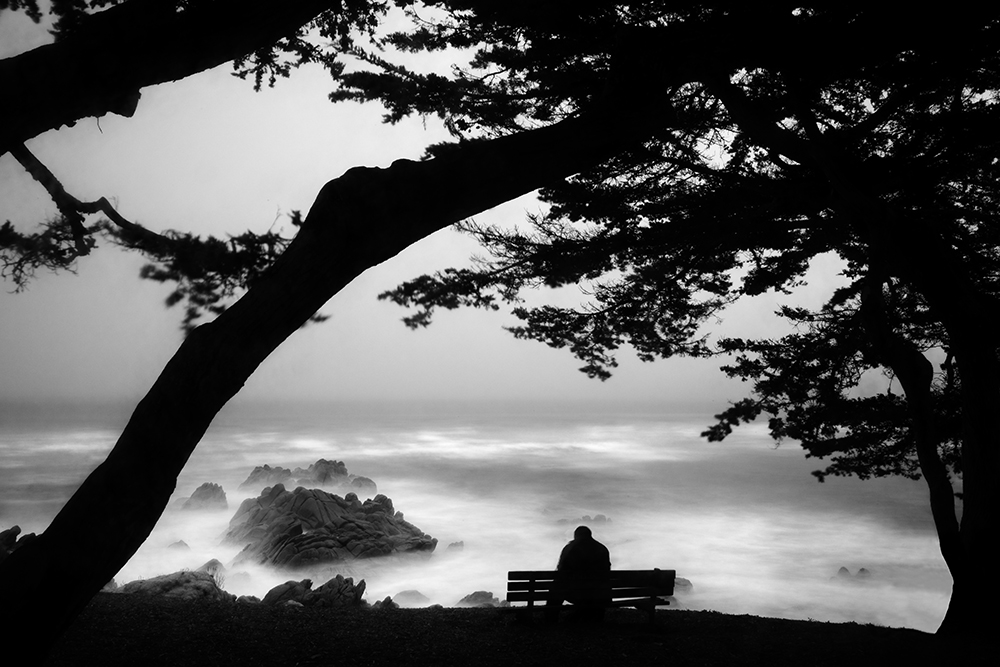
Lone Man No 30
When I speak to camera clubs, I’ve noticed that most of them have some sort of monthly competition and/or the critiquing of images. And if you’ve read my blog for very long, you know that I am not a fan of either.
Starting with my article “Art is Not a Competition” and ending with my “Why I Don’t Critique Other People’s Work” I’ve argued that neither competition or critiquing is conducive to developing one’s own Vision.
Instead I’ve made the case that rather than learning about what others think of your work, you should decide how you feel about it. And that can only come from having a Vision and then honestly appraising how well you expressed that Vision.
Recently, after one of my presentation and during the Q&A session that followed, someone asked me this question (paraphrased):
“So based on what you’ve said tonight, I’m guessing you would not agree with our club’s monthly competition and critiquing of images?”
Wow, what was I going to say? I had met with the club’s executive committee earlier that evening and had learned about their many well organized activities, which included those monthly competitions and critiques. These were nice people, good people, sincere people who believed in what they were doing.
In a split second I had to decide how to answer that question: should I avoid giving offense by offering an artful “non-answer” or should I tell the truth?
I told the truth.
As I stood there expressing my opposition to competitions and critiques, the thought occurred that I should also offer an alternative. And so here is my suggestion to camera clubs as an alternative to competitions and photo critiques.
Once a year have each person bring an image that they really love and have them explain the story behind the image.
- How they came to create it.
- Did they have a Vision for that image, and if so, when did it emerge?
- Have them talk about their creative process.
- Have them explain where they feel that they hit or missed the mark.
- Have them tell the group why they love this image (this is the most important item!)
The person should be encouraged to not discuss where the image was taken, the equipment they used or their processing tools (do we care where da Vinci painted the Mona Lisa or what brushes he used?). The discussion should be about the image, the Vision that created it and how the creator feels about their work.
And then let the audience ask questions and make supportive comments. Instruct the audience not to discuss the technical aspects of the image or ask technical questions and most importantly, refrain from giving advice or explaining how they themselves would have created this image.
In a sense this would be a “show and tell” that focuses on what the person intended and how they feel about their work, rather than what others think or would have done.
Initially some may find this approach challenging, because they may not feel that they have a Vision, while others may want to ask technical questions and offer suggestions. But with a good moderator and some practice, I think that it would be beneficial to focus on the creator and their Vision.
If you think this idea has merit, please suggest it to your club!
Cole
July 24, 2015
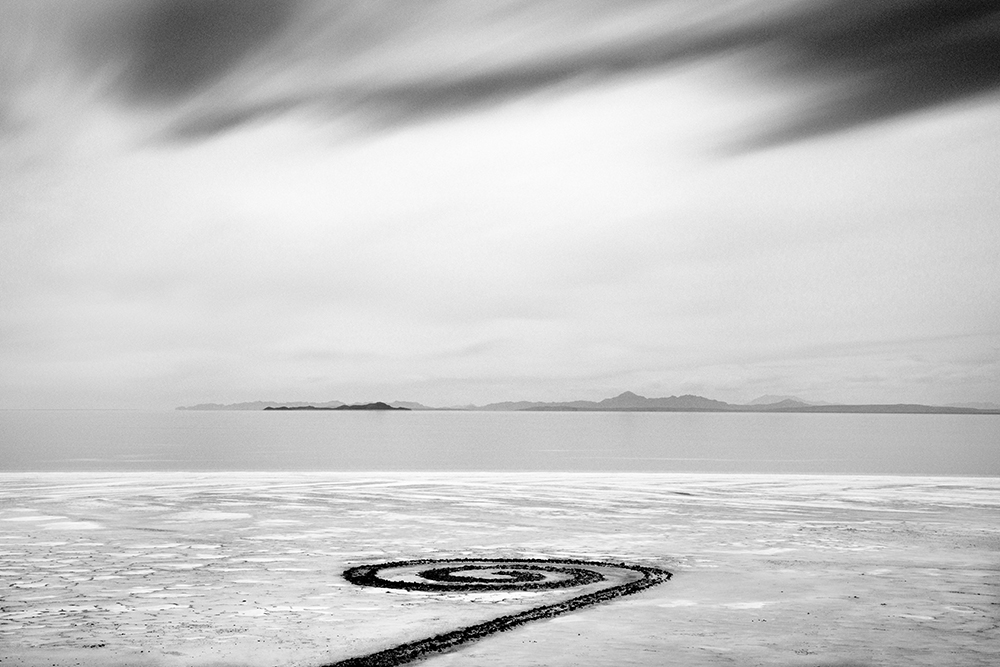
Spiral Jetty
Sometimes it seems that everyone is either an expert or a critic! Show your work to 10 people and you may well end up with 10 different opinions about your image. Why? Because everyone has an opinion.
So who should you listen to when it comes to your images? Family, friends, art experts, gallery owners, curators, MFA’s, other successful photographers? Who?
My suggestion is that you ignore all criticism, praise and advice and listen only to yourself. Why? Because other people’s comments about your image reflects their tastes, their ideas and their Vision. So no matter how well intentioned or how much of an “expert” they are, their advice is going to miss the mark when it comes to your Vision.
We all know how damaging harsh criticism can be; it can discourage, demotivate and cause you to doubt your potential. But even constructive criticism delivered in a kind and gentle way can mislead you and take you off track. That’s because others don’t know your Vision of the image, only you know that.
I was once told that I should not center “The Angel Gabriel.” At first this advice caused me to doubt my Vision and I actually tried to re-crop the image off center. It was a disaster because that was not how I saw the image. Right or wrong, for better or for worse, centered was the way I see Gabriel.

Strangely enough, I also find that praise can be disruptive to Vision. Praise sounds so sweet and we so want to believe it, but it can take us off track. There are many images that I’ve pursued but did not love simply because they generated praise. Praise is addictive and hard to ignore, but you must for the same reasons you should ignore criticism.
There was a time in my photographic life that I would ask people what they thought about my work. Why? Because I didn’t know where I was going and I mistakenly thought I could find the answers by asking others. I could not.
There’s an infinite number of voices out there and even if you had the time to listen to all of them, that would not help you find your Vision. That can only come from a great deal of hard work and solitary introspection. There is no other way.
So how do I view criticism, praise and advice? I try to be appreciative of the person’s sincere intentions but take their advice with a grain of salt and do my best to not let it sway my own opinion of my work (for good or for bad). Only I know my Vision and how closely I hit or miss the mark, and for that reason I believe that my opinion is the only one that matters.
When I see people asking for advice on their images, it suggests to me that they may not have found their Vision. And when you have not found your Vision, you are uncertain and need advice and reassurance from others.
Find your Vision and ignore criticism, praise and advice.
Cole
P.S. If you need help finding your Vision, here is the story of how I went about finding mine.
May 28, 2015
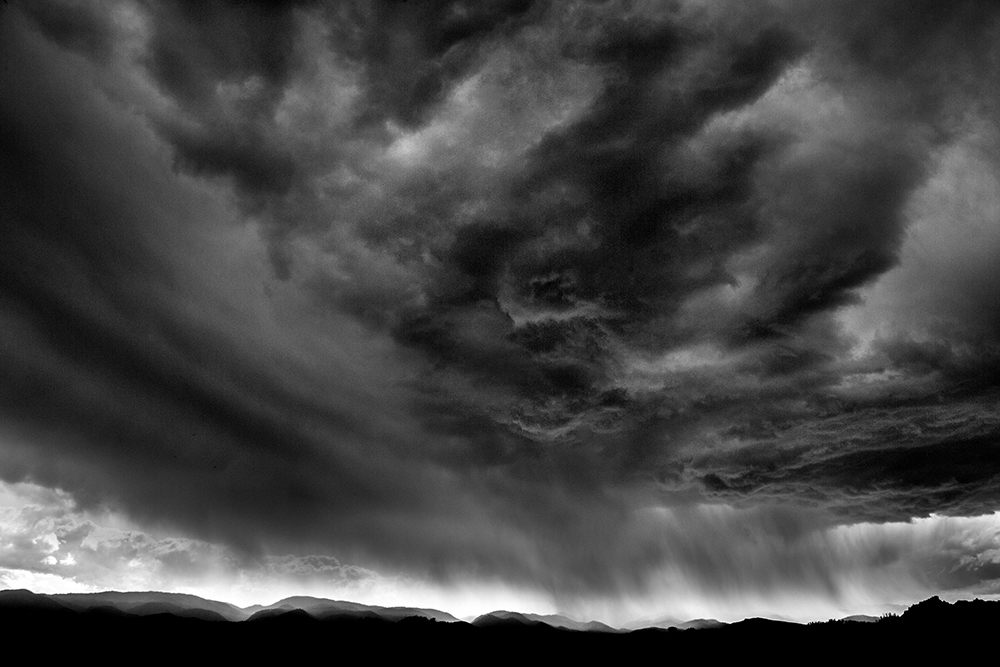
Storm Cloud, 2015
.
I have been accused of being arrogant for suggesting that the source of my Vision lies within myself and is not dependent upon the outside world or those who have gone before me.
I don’t believe this to be an arrogant idea. But here are some additional thoughts that may convince the unconvinced that I am in fact, arrogant.
.
Look inward.
Everything you need is already there.
Discover your Vision.
See for yourself.
.
We are all creative as children.
But then we learn how to seek approval.
And something atrophies and almost dies.
We forget how to please ourselves.
.
There is a difference between Vision and Inspiration.
Inspiration comes from without, Vision comes from within.
A person can only do so much with Inspiration.
Inspiration without Vision is an unproductive effort.
.
Look inward.
Ignore what others are doing.
Do what you feel inspired to do.
Create work that you love.
.
Art is very selfish.
Or at least it should be.
If you are creating for others,
then you are not creating your best work.
.
Do not compare your work to other’s.
Judge your art only by how you feel about it.
Create art that you are proud of.
Create art that you love.
.
Look inward.
You harbor that secret ingredient.
The secret to success.
Your Vision.
.
.

